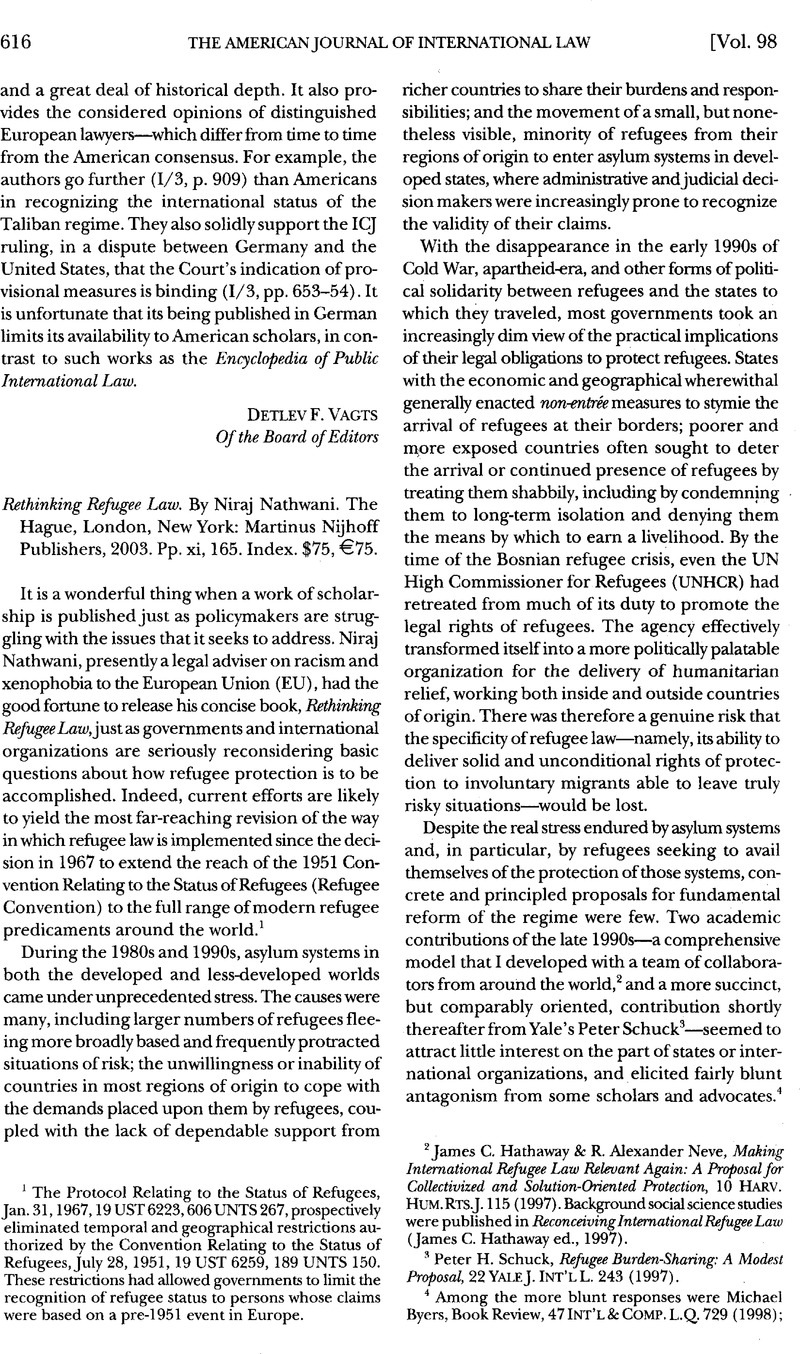No CrossRef data available.
Article contents
Rethinking Refugee Law. By Niraj Nathwani. The Hague, London, New York: Martinus Nijhoff Publishers, 2003. Pp. xi, 165. Index. $75, €75.
Published online by Cambridge University Press: 27 February 2017
Abstract

- Type
- Recent Books on International Law
- Information
- Copyright
- Copyright © American Society of International Law 2004
References
1 The Protocol Relating to the Status of Refugees, Jan. 31, 1967, 19 UST 6223, 606 UNTS 267, prospectively eliminated temporal and geographical restrictions authorized by the Convention Relating to the Status of Refugees, July 28, 1951, 19 UST 6259, 189 UNTS 150. These restrictions had allowed governments to limit the recognition of refugee status to persons whose claims were based on a pre-1951 event in Europe.
2 Hathaway, James C. & Alexander Neve, R., Making International Refugee Law Relevant Again: A Proposal for Collectivized and Solution-Oriented Protection, 10 Harv. Hum. Rts. J. 115 (1997)Google Scholar. Background social science studies were published in Reconceiving InternationalRefugee Law (James C. Hathaway ed., 1997).
3 Schuck, Peter H., Refugee Burden-Sharing: A Modest Proposal, 22 Yale J. Int’l L. 243 (1997)Google Scholar.
4 Among the more blunt responses were Michael Byers, Book Review, 47 Int’l & Comp. L.Q. 729 (1998)Google Scholar; Juss, Satvinder, Toward a Morally Legitimate Reform of Refugee Law: The Uses of Cultural Jurisprudence, 11 Harv. Hum. Rts. J. 311 (1998)Google Scholar; and, in particular, Anker, Deborah, Fitzpatrick, Joan, and Shacknove, Andrew, Crisis and Cure: A Reply to Hathaway/Neve and Schuck, 11 Harv. Hum. Rts. J. 295 (1998)Google Scholar. A thoughtful review of these and other critiques is provided in Harvey, Colin, Talking About RefugeeLaw, 12 J. Refugee Stud. 101 (1990)Google Scholar.
5 Feller, Erika, Preface, in Refugee Protection in International Law: Unhcr’s Global Consultations on International Protection, at xvii, xvii (Feller, Erika, Volker, Türk, & Nicholson, Frances eds., 2003)CrossRefGoogle Scholar.
6 Id. at xviii.
7 UNHCR Executive Committee, Global Consultations on International Protection: Report of the Meetings Within the Framework of the Standing Committee (Third Track), UN Doc. A/AC.96/961 (June 27, 2002):
8 UN Doc. A/AC.96/965/Add.1 (June 26, 2002) (endorsed by the UNHCR Executive Committee in October 2002).
9 Chairman’s Summary, Global Consultations: Protection of Refugees in Situations of Mass Influx (8–9 March 2001), at 2, in Refugee Survey Q., Oct. 2003, at 84, 85.
10 For a discussion of the legality of this exercise, see Hamaway, James C., Refugee Law Is Not Immigration Law, in Canadian Council on International Law, Globalism: People, Profits and Progress 134 (2002)Google Scholar, an edited version of which appears in the World Refugee Survey 2002, published by the U.S. Committee for Refugees.
11 Australia Department of Immigration and Multicultural Affairs, Refugee and Humanitarian Issues : Australia’s Response 5 (Oct. 2001).
12 UNHCR Press Release, Lubbers Proposes “Convention Plus” Approach (Sept. 13, 2002)Google Scholar.
13 United Kingdom, A New Vision for Refugees 1 (Mar. 7, 2003).
14 Id. at 11.
15 Id. at 30.
16 The commitment is vague, at best “Countries would be persuaded to host a Regional Protection Area largely because they are probably dealing with a large refugee population already. The international community would therefore offer to support that refugee population in a better way.” Id. at 13.
17 Letter from Tony Blair, UK Prime Minister, to Costas Simitis, European Council President (Mar. 10, 2003)Google Scholar.
18 The proposal was first presented by High Commissioner Lubbers at a meeting in London on March 17, 2003. A slightly revised version was formally presented later that month: UNHCR, Statement by Mr. Ruud Lubbers, United Nations High Commissioner for Refugees, at an Informal Meeting of the European Union Justice and Home Affairs Council (Mar. 28, 2003). The proposal was further refined in the UNHCR working paper, UNHCR’s Three-Pronged Proposal (June 2003).
19 Communication to the Council and the European Parliament: Towards More Accessible, Equitable and Managed Asylum Systems, COM(03)315final (June 3).
20 Interestingly, though Nathwani does open his study by conceding the general view that “refugee law faces a severe crisis” (p. 1), the only audiority that he cites in support of this position is Gil Loescher’s edited 1992 volume, Refugees and the Asylum Dilemma in the West. More recent concerns, as well as the proposals to address them, are essentially absent from the book.
21 Walzer, Michael, Spheres of Justice: A Defense of Pluralism and Equality 33–35 (1983)Google Scholar.
22 Carens, Joseph H., Nationalism and the Exclusion of Immigrants: Lessons from Australian Immigration Policy, in open borders? Closed societies? The Ethical and Political Issues (Gibney, Mark ed., 1988)Google Scholar.
23 Atle, Grahl-Madsen, 1 The Status of Refugees in International Law 78 (1966)Google Scholar.
24 Hathaway, James C., Reconceiving Refugee Law as Human Rights Protection, 4 J. Refugee Stud. 113 (1991)CrossRefGoogle Scholar.
25 He analysis proceeds as follows:
General principles in international law are usually vague. These principles can be considered only within the framework of a national legal culture, whereas international law needs to accommodate vastly different national traditions. Thus, general principles in international law will be “thin” in the sense that they only contain the minimal common denominator. . . .
Within the context of refugee law, it is pertinent to point out that the 1951 Refugee Convention provides for decentralised decision making. . . . Thus, international law can only play the role of directing attention to the applicable legal principles and leaving the concrete shape of the principle to national law. (P. 35)
26 Richmond, Anthony H., Global Apartheid: Refugees, Racism, and the New World Order (1994)Google Scholar.
27 R. v. Sec’y of State for the Home Dep’t, ex parte Adan, [2001] 1 All E.R. 593, 605 (H.L. 2000) (Steyn, L.J) .




